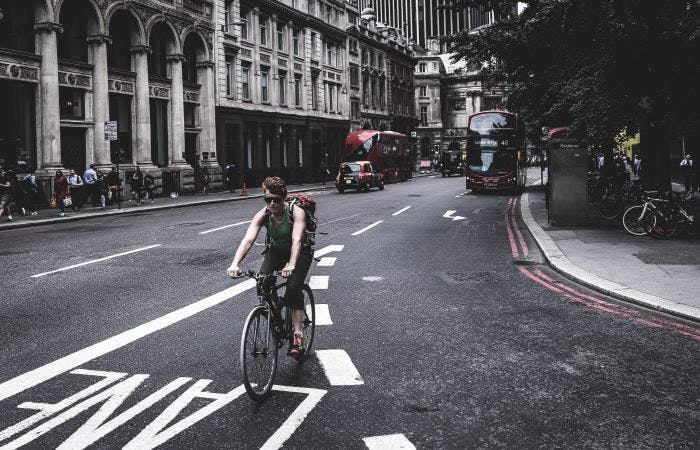
It goes without saying that the relationship between drivers and cyclists is antagonistic. From nervous novices flummoxed about how to deal with two-wheelers through to veteran motorists irate at being held up yet again, it’s easy to see where the irritation comes from. However, the truth remains that cyclists are vulnerable out there on the road. As such, you must take appropriate care while behind the wheel in order to keep them—and yourself—safe on the roads.
In this guide, we’ll share a few top tips to help you figure out exactly how you should be driving around cyclists and how you can stay safe.
Why is it so important to pay attention to cyclists?
With environmental issues gaining increasing prominence, more of us than ever are making greener travel choices. For some, this means switching to an eco-friendly car. However, there’s no cleaner fuel source than good old-fashioned pedal power, and, as a result, cycling is unmistakably on the rise.
Nonetheless, the roads remain a dangerous place for those on two wheels. Statistics from the DVSA show that, in the year ending June 2018, there were 17,520 total cyclist casualties—3,780 of which were killed or seriously injured. Though this number is, thankfully, declining, it still represents thousands of avoidable, life-changing accidents. With this in mind, the onus is on motorists to drive in a safe, considerate manner to help keep all road users safe.
Tips to stay safe when driving around cyclists
1. Give them plenty of room
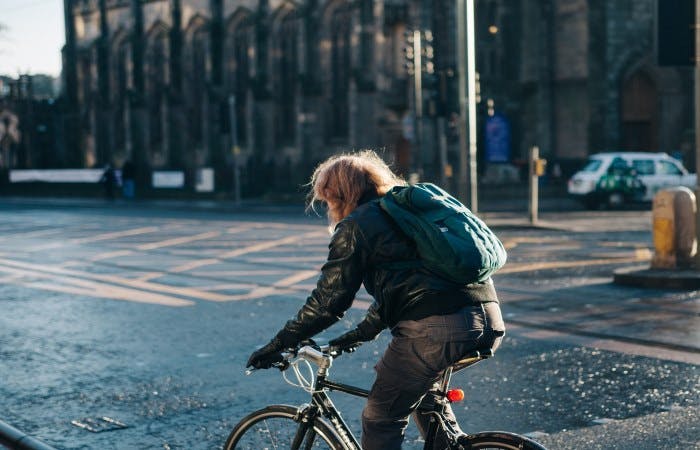
One of motorists’ most common complaints regarding cyclists is the amount of room they need. After all, a bike is much smaller than a car—surely they can just get out of the way, right?
Wrong. As a cyclist, you’ve got plenty of hazards to deal with at any given time, from potholes to parked cars. Worse still, you’re also exposed to the elements. A sudden gust of wind is nothing when you’re sheltered inside a car, but on a bike, it can blow you way off course.
Add into the mix the problem of tailgating. This is already incredibly annoying when you’re in a car. Now imagine that, but instead of being in a fairly safe vehicle, you’re have no protection at all should someone hit you. It’s terrifying!
All of this is to say that, while bikes may look pretty small, it’s important to give them plenty of room. In fact, if you’re driving alongside a cyclist, you should try to give them as much space as you would a vehicle. Aim for a distance of around 1.5 metres (or 5 feet).
Still feel a bit aggrieved that cyclists need so much space? Well, one thing that you may not realise is that the Highway Code itself actually encourages them to move to the centre of the road when they feel it’s safer to do so.
2. Be careful at junctions
Observations at junctions are vital for any road user. However, many drivers make the mistake of thinking that you need only look out for cars. In reality, it’s also just as important that you keep an eye out for cyclists. Far less easy to spot than motorists, a cyclist might come up behind you without you noticing—attempting to overtake you or filtering through traffic.
When you’re preparing to emerge from any type of junction, you should slowly creep forward so that you have a good enough view of both sides of the road. Take special care to look in both directions for any approaching cyclists. If you see one, you might want to wait for them to pass before you move. Even if you’re confident you can emerge before they reach you, they could be moving at a faster speed than you realise.
Though it might be hard to believe, cyclists won’t always be aware that you’re driving behind them. If they’re approaching a junction, for example, they might be so preoccupied with making the right turn that they forget to glance around for nearby cyclists. If you think a cyclist hasn’t spotted you, don’t attempt to move past them—they might swerve into you accidentally.
Are you a driver/cyclist hybrid? Don't forget to get a good bike rack to keep your 4-wheeled and 2-wheeled friends secure on the road.
3. Watch out when turning
Whether you’re switching lanes, turning left or turning right, it’s vital that you stay alert for any cyclists nearby. If you’re turning across oncoming or stationary traffic, for example, you should leave a safe gap and check for any cyclists on the inside of any traffic you’re crossing. Again, cyclists can move at high speeds, so if you’re not sure you can make the turn before they reach you, wait. Be sure to check your mirrors and blindspots to make sure a cyclist isn’t attempting to overtake you before you turn. If they are, wait for them to pass before you move.
It can become an even more difficult situation if you’re turning from left side to left side. In this kind of scenario, you could end up unknowingly blocking cyclists from your view. That’s why you’ve got to make sure your observations are up to snuff when you make the turn.
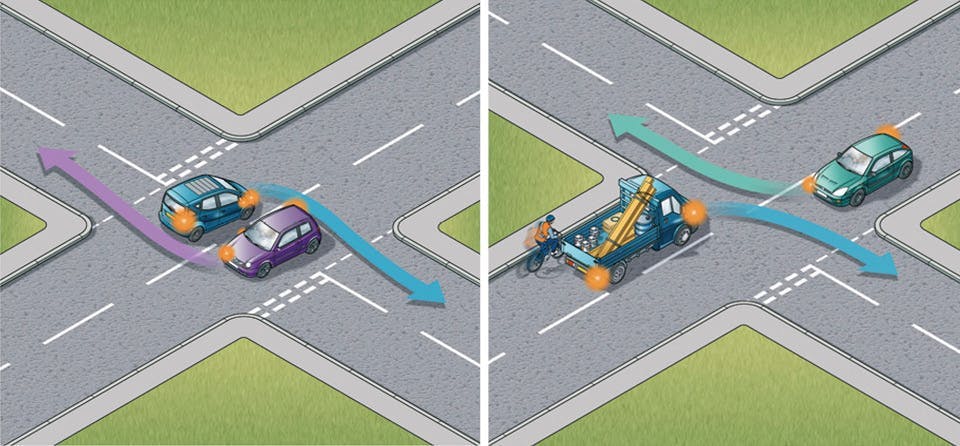
Left - Turning right side to right side. Right - Turning left side to left side © Crown copyright (Open Government Licence)
4. Overtake with caution
Travelling at slower speeds, cyclists have a tendency to hold traffic up. When this happens, it can be all too tempting to succumb to your road rage and overtake—even when it can be risky to do so.
It should go without saying that this is a no-no. You should only overtake a cyclist when it’s safe and legal to do so. If you’re on a narrow road, approaching a hill or located near a blind turn, then you should rule it out entirely.
If you’ve decided that it is indeed safe for you to overtake a cyclist, then you should leave plenty of room as you do. This means that if a cyclist needs to move, the chances of a collision are lowered.
The rules change, however, when it comes to junctions. If you’re following a cyclist on approach to a roundabout or junction, you should stay behind and wait until you’ve emerged onto the new road. Then, follow the rules above—wait until it’s safe and then overtake them.
5. Stay vigilant
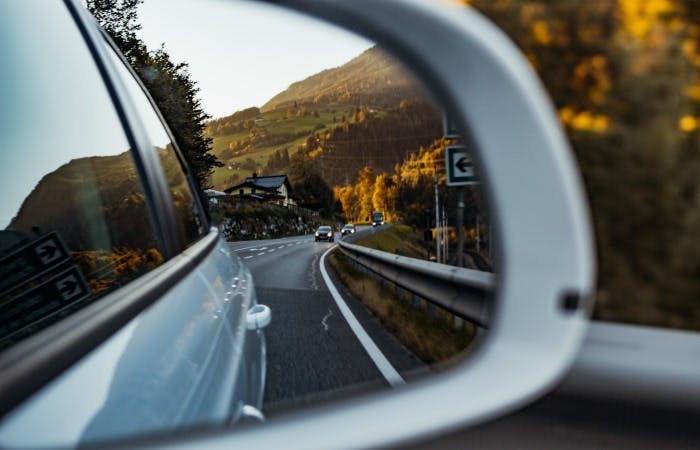
Accidents on the road almost always occur because of inadequate observations. Generally speaking, you should check your mirrors and blindspots regularly as you drive, with this becoming even more important as you approach or emerge from a junction, when you accelerate or decelerate, and when you complete any kind of manoeuvre. Ideally, however, you should be checking your mirrors every minute or so—a cyclist is bound to catch you off guard if you’re not careful enough.
If you forget to check your mirrors and blindspots before switching lanes, for example, you could end up colliding with a cyclist who was attempting to overtake you. A great number of cyclists are in the habit of weaving in and out of traffic, so it’s important you’re vigilant. Be sure to keep an eye on both sides of your car, as a cyclist could attempt to overtake you on either side.
Though we shouldn’t have to say it, you should take even greater care when completing a reversing manoeuvre. A cyclist might not be aware that you’re reversing out of a bay, for example, until it’s too late. It’s up to you, then, to make sure your observations are on point.
6. Adapt your driving style
Road, traffic and weather conditions are always changing, so your driving style needs to keep up. In the event of heavy rain or snow, for example, you’ll have to give cyclists even more room to manoeuvre. If they end up slipping, you don’t want to be right behind them. Remember, if the weather conditions are making it difficult for you to drive, it’s going to be even more challenging for cyclists.
Don’t be fooled into thinking weather is the only thing that counts. Roadworks, uneven road surfaces and other hazards may cause cyclists to change their speed or direction. You should also take care to pay extra attention as you move from main roads towards residential areas, where you’re more likely to come across bikes.
7. Stop at the line
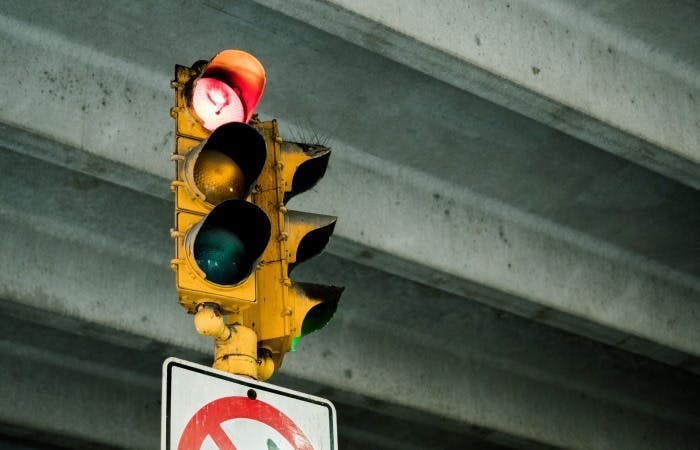
Road markings are there to help keep motorists and cyclists alike safe. Take cyclist waiting areas, for example. These areas feature at certain junctions in order to allow cyclists to position themselves ahead of other traffic. It gives them the chance to get ahead once the lights turn green. If you see this area ahead of you, and the lights are ready to turn red, you need to stop at the first white line. Once the light’s green, if there are cyclists in front of you, you need to pause and give them time to move off.
It’s not just these areas that you need to be aware of. You should not drive in a cycle lane that has a solid white line during its times of operation. Though you’re technically allowed to drive in cycle lanes marked by a broken white line, you should only do so when it’s absolutely necessary. When you do, you should check your mirrors to make sure there aren’t any approaching cyclists attempting to use the lane. If you ignore these rules, you run the risk of forcing a cyclist to weave through traffic instead.
8. Reduce speed when necessary
No matter how many times some drivers are told, they seem to forget that speed limits are merely the absolute maximum that they should be driving at—they do not mean that it’s safe to drive at that speed, at all times. Instead, you should take note of the road conditions and adjust accordingly.
If you’re driving around cyclists, then you almost certainly shouldn’t be driving at the maximum speed limit. Instead, you should reduce your speed. Sharing the road with others means that you need to be respectful of their safety at all times.
9. Watch for their signals...and provide your own
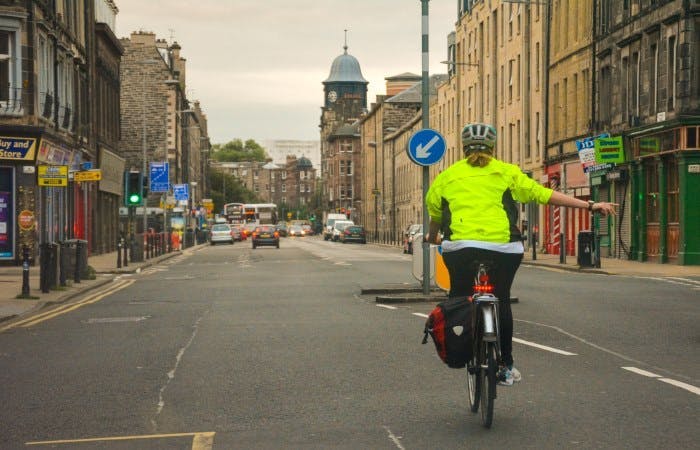
If you spot a cyclist in front of you, you should glance at them every now and again just in case they give you a signal that lets you know what they intend to do next. Whilst they might not have indicators like you, there are a few things they can do to help you predict their next move. For starters, many cyclists will be helpful enough to use their arms in lieu of indicators—telling you exactly when they intend to turn into a road. Other clues aren’t as overt, of course. If a cyclist looks behind them, for example, they might be preparing to change direction.
As important as it is to watch out for their signals, it’s just as vital that you provide your own. Don’t delay with your signals—the sooner you check your mirrors and signal, the sooner a cyclist can prepare accordingly. If they know you’re preparing to turn, they might decide it’s too risky to overtake you. Give them plenty of time to react and everyone will be better off for it.
10. Be careful with your door
You wouldn’t attempt a manoeuvre without first checking your mirrors and blindspots. Opening your car door should be no different. Whether you’ve quickly parked up at the side of the road to nip into the shop, or you’re stopping off at home, you need to check it’s clear before you open your door. Cyclists aren’t as easy to spot as motorists, so if you’re not careful, you could swing open your door and knock a cyclist off their bike.
Whenever you intend to open your car door, you should pull the handle with the arm that is furthest from the door. This will force you to glance over your shoulder at your blindspot—the very space in which a potential cyclist, motorist or pedestrian might be. This ‘manoeuvre’ is otherwise known as the Dutch Reach, and should become a part of your everyday routine.
And that’s all there is to it! If you’d like more information on how you should be driving and how to keep other road users safe, we’d suggest reading up on the Highway Code. It doesn’t matter how long you’ve been driving, you should take the time to refresh your knowledge and make sure you’re up to speed with the rules of the road!
Subscribe for driving advice, offers & more
We'd love to let you know about our courses, news and offers via email. You may unsubscribe at any time.
Star Genie Limited trading as PassMeFast. Company number 10093359
Copyright © 2024 owned by Star Genie Limited
PassMeFast, Blue Tower, MediaCityUK, Salford, M50 2ST

